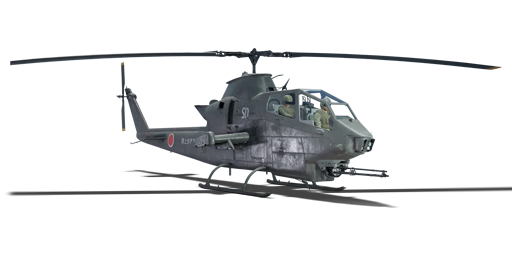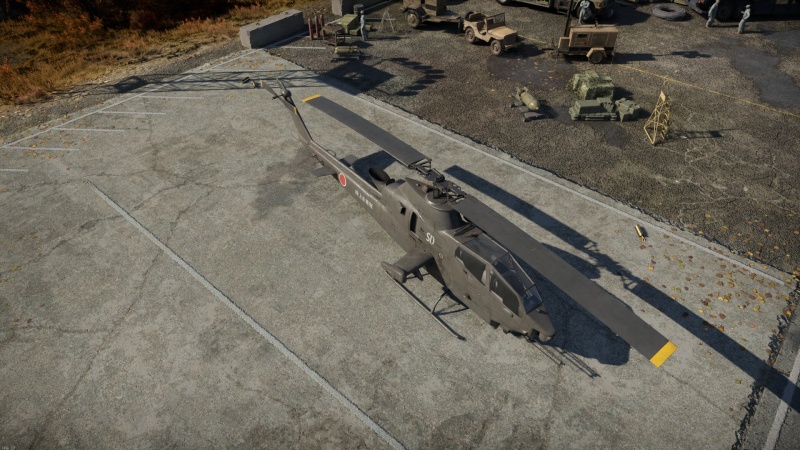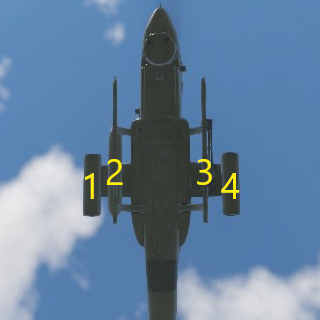AH-1E (Japan)
| This page is about the Japanese attack helicopter AH-1E (Japan). For other versions, see AH-1 (Family). |
Contents
Description
The ▅AH-1E is a step 2 Cobra variant bought by the Japanese for trials in the consideration of attack helicopters as a branch. After positive results and coming to a deal, Japan ordered the license production of step 3 Cobras, becoming the AH-1S.
It was introduced in Update "Starfighters". As an earlier Cobra model, it doesn't come with TOW-2s or thermal NVD imaging unlike its later variant the AH-1S / AH-1S Kisarazu. It is more like a flying ATGM carrier than an independent helicopter that can snipe from afar. The TOW missiles are powerful, but they can only reach 3.75 km, which is shorter than the range of the AA systems that the Cobra will encounter. The best way to play the AH-1 is to support the ground team and jet aircraft, and let them handle the SPAA/SAM, planes, and other helicopters.
- If the team fails to claim aerial supremacy, the helicopter crew should fly low and hide behind buildings or terrain, fire a missile at a target and then move away, and repeat this tactic.
- If the skies are clear, the helicopter crew can fly higher and see more of the battlefield, fire missiles at ground targets, and provide information to the team before returning to the helipad for more missiles.
General info
Flight performance
The AH-1E has a single turboshaft T53-L-703 power plant, providing up to 1351 BHP & 220 kgf with a mass of 350 kg. This turboshaft engine is able to push the AH-1E to speeds in excess of 277 km/h whilst carrying wing-mounted armaments.
| Characteristics | Max Speed (km/h at 1,000 m) |
Max altitude (metres) | |
|---|---|---|---|
| AB | RB | ||
| Stock | 255 | 243 | 3475 |
| Upgraded | 295 | 277 | |
Survivability and armour
The AH-1E is an armoured attack helicopter offering protection to the crew and engine:
- Composite boron carbide seat enclosures, for both of the crew, with a thickness of 20 mm.
- A steel seat, which offers a thickness of 12 mm for the pilot only.
- Steel plate covers, offering 12 mm of thickness over the turboshaft engine.
The AH-1E compensates with its small and nimble size compared to the Mi-24 Hinds which are incredibly well armoured but are huge and slow in comparison. However, the AH-1E does not protect all of its critical components, such as the fuel tanks, transmission, propeller shaft, and control surfaces, with armour plating, nor does it have armoured glass installed around the cockpit.
Modifications and economy
Armaments
| Ballistic Computer | ||
|---|---|---|
| CCIP (Guns) | CCIP (Rockets) | CCIP (Bombs) |
| |
|
|
Offensive armament
The AH-1E (Japan) is armed with:
- 1 x 20 mm M197 cannon (750 rpg)
Suspended armament
The AH-1E (Japan) can be outfitted with the following ordnance presets:
- Without load
- 76 x FFAR Mighty Mouse rockets
- 28 x FFAR Mighty Mouse rockets
- 4 x BGM-71C Improved TOW missiles
- 8 x BGM-71C Improved TOW missiles
- 2 x 7.62 mm M134 Minigun machine guns (1,500 rpg = 3,000 total)
Custom loadout options
| 1 | 2 | 3 | 4 | ||
|---|---|---|---|---|---|
| 7.62 mm M134 Minigun machine guns (1,500 rpg) | 1 | 1 | |||
| FFAR Mighty Mouse rockets | 7, 19 | 7, 19 | 7, 19 | 7, 19 | |
| BGM-71C Improved TOW missiles | 2, 4 | 2, 4 |
Usage in battles
When playing the AH-1E, select the helipad which is in the ideal tactical location for your playstyle. Climb to around 1,500 meters, find a target, then descend on to them. For optimal effectiveness, it is important that you engage them from the rear or the side. As pilots primarily scan in front of themselves for targets, attacking from behind will give you the advantage of not being seen. When shadowing the target, approach as fast as possible to close the gap to within TOW range. After slowing, engage the sight stabilizer and fire the TOW missile and guide it to the target.
If the target tries to evade, keep the missile on the target and adjust to counter any manoeuvres your adversary may attempt.
Perhaps most importantly, if out of TOW range, the missile will self-detonate and could give your position away, if your adversary is attentive and sees the explosion.
| Remember you only have around one and a half miles before the missiles will detonate by themselves. |
After gaining experience while playing with the BGM-71 missiles, you will be able to determine when you are within range based on that experience. This also applies to any other type of missile in the game too.
When engaging in close quarters combat with other helicopters, the biggest threats are air to air missiles- The AH-1E does not offer any protection against them with countermeasures such as flares or IRCM. This means you need to stay alert, active & on the lookout for fast moving dots. If you see a small fast dot heading towards you, make very sharp abrupt turns, change height at the same time while turning and rolling.
| These are the biggest threats to you in battle since they can carry air-to-air missiles |
| You may even be able to shoot down missiles with the installed 20 mm triple rotary M197 cannon. |
When engaging other helicopters, the triple barrel rotary cannon makes short work of any adversary. Make sure to load it with the air target belt, aim for critical elements of the rival helicopters such as cockpit, engine and fuel tanks. If you have equipped your helicopter with the additional twin M134 miniguns, bring your target in front of you and open fire. They will obliterate the target and send a flaming wreck to the ground. The fast fire rate will chew through ammo at a rapid rate, but when fully loaded have 3,000 rounds in total. That's 1,500 rounds per mini gun, in addition to the 750 cannon rounds for the M197, potentially up to 3,750 rounds total!
Ground forces
When playing the AH-1E in ground forces, it is recommended to load up the 8 x BGM-71 TOW missiles + 38 x FFAR Mighty Mouse missiles. The BG-71 will give you the penetration at range in order to terminate tankers and with safety from the anti-aircraft missile equipped anti-air vehicles. It is a wise tactic that anti-aircraft missile equipped anti-air vehicles to be terminated first. Then once terminated, move into the battlefield and dominate the tanks with the 38 x FFAR Mighty Mouse missiles, which can cause a lot of damage and could potentially terminate up to 38 tanks with well-placed shots.
The ideal tactic is to utilize the helicopter and the terrain. Such as maps which have forests and lots of tree lines, stay low over the trees and select your targets based on the threat to yourself first, then the impact to the team.
For example, if you have seen no enemy SPAA vehicles or other helicopters, climb in height, hover, then fire one or two missiles. Then quickly break off the hover and move to another part of the map, this way it allows you to stay undetected, remain stealthy and become a major threat to the enemy team.
Handling radar and surface-to-air missiles, when an enemy missile equipped SPAA is achieving a lock on, you will be notified with red arrows on the screen saying radar. To break the lock start rolling, gaining speed and the arrows will go away. If you are not successful, keep a close watch around the helicopter. At this, you will see white smoke coming from the ground, make very sharp abrupt turns. Change height at the same time while turning and rolling to avoid the missile.
Pros and cons
Pros:
- Great manoeuvrability
- Very agile, with secondary load outs installed
- Good secondary weapon loadout
- IR Thermal vision for cannon/ATGM camera and image intensifier for the pilot/gunner
- Joystick specific handling characteristics:
- Easy to recover from adverse roll (retreating blade stall) at high speeds
- Has SAS mode assistance support (dampening mode only)
- Good pitch authority at high speeds
Cons:
- Slow takeoff spool-up and acceleration
- No missile protection
- No IRCM
- No air-to-air missiles
- Poor missile range
- Somewhat heavy even without additional ordinances,
- Strong tendency to fall into a vortex ring state
- Joystick specific handling characteristics:
- Retains energy rather poorly in turns
- Rotor RPM tends to drop easily
- Moderately strong adverse roll (retreating blade stall) at high speeds with poor roll control
- Has a light tendency to nose over but generally doesn't tend to fall into an inverted spin
- Moderately poor adverse yaw/roll/pitch stability characteristics
- Centre of gravity sits behind the stub wings' center of lift
History
Describe the history of the creation and combat usage of the helicopter in more detail than in the introduction. If the historical reference turns out to be too long, take it to a separate article, taking a link to the article about the vehicle and adding a block "/History" (example: https://wiki.warthunder.com/(Vehicle-name)/History) and add a link to it here using the main template. Be sure to reference text and sources by using <ref></ref>, as well as adding them at the end of the article with <references />. This section may also include the vehicle's dev blog entry (if applicable) and the in-game encyclopedia description (under === In-game description ===, also if applicable).
Media
- Skins
See also
- Related development
- Bell AH-1 SuperCobra
- Aircraft of comparable role, configuration and era
- Agusta A129 Mangusta
External links
Paste links to sources and external resources, such as:
- topic on the official game forum;
- other literature.
| Fuji Heavy Industries, Ltd. (富士重工業株式会社) | |
|---|---|
| Utility | UH-1B Hiyodori* |
| Attack | ▅AH-1E* · AH-1S* · AH-1S Kisarazu* |
| AH-64DJP* | |
| *Licensed | |
| Fuji Heavy Industries traces its roots to the Nakajima Aircraft Company. At the end of World War II, Nakajima was broken up by the Allied Occupation government, and by 1957 part of the separated company was already known as Fuji Heavy Industries.
Fuji Heavy Industries was renamed to Subaru Corporation from 2017 onward. | |
| See also | Nakajima Aircraft Company (1918-1945) · Bell Aircraft Corporation · Boeing Aircraft |
| Japan helicopters | |
|---|---|
| Utility | ▅UH-1B |
| Attack | ▅AH-1E · AH-1S · AH-1S Kisarazu |
| AH-64DJP | |






